What makes up the probe configuration in ultrasonic welding?
The probe configuration in ultrasonic welding typically consists of a converter, a booster, and a horn. The converter is a piezoelectric transducer that converts electrical[…]
What are the phases of welding in ultrasonic welding?
In ultrasonic welding, there are typically four phases of welding: The parameters such as amplitude, pressure, and time can be varied during each phase to[…]
What are bad part limits in ultrasonic welding?
Bad part limits in ultrasonic welding refer to the set of conditions or characteristics of a welded part that deem it unacceptable or unsatisfactory for[…]
What is welding by position or absolute distance mean in ultrasonic welding?
Welding by position or absolute distance in ultrasonic welding refers to controlling the weld process based on the actual position or distance between the horn[…]
What does Weld By Distance mean in ultrasonic welding?
Welding by distance is a method of controlling the ultrasonic welding process based on the distance traveled by the ultrasonic horn during the welding cycle.[…]
What does Weld By Energy mean in ultrasonic welding?
Welding by energy is a method of controlling the ultrasonic welding process based on the amount of energy delivered to the joint, rather than the[…]
What is Weld By Time in ultrasonic welding?
Welding by time is a method of controlling the duration of ultrasonic energy applied during the welding process. In this method, the ultrasonic generator is[…]
What is a shear joint in ultrasonic welding?
A shear joint is a type of joint commonly used in ultrasonic welding that involves joining two materials in a parallel configuration. In this joint,[…]
How do mold release agents affect in ultrasonic welding?
Mold release agents are typically used to facilitate the release of plastic parts from the mold during the injection molding process. However, these agents can[…]
How does hygroscopicity affect in ultrasonic welding?
Hygroscopicity is the ability of a material to absorb moisture from the environment. In ultrasonic welding, the presence of moisture can have a significant impact[…]

